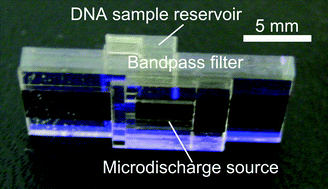This paper reports a discharge-based optical source for fluorescence of biochemicals in microfluidic systems. Its efficacy is demonstrated using a stacked microchip that integrates a microfluidic wavelength-tunable optical source, a biochemical sample reservoir and optical filters. It is shown to excite fluorescence in L-tryptophan and DNA samples labeled by SYBR green dye. The discharge is struck in ambient air, between a metal anode and a cathode cavity that is filled with an aqueous solution, which is doped with a metal salt selected for its emission characteristics. The characteristic line spectra, which arise from energetic transitions of the metal ions that are sputtered into the glow region of the discharge, are optically filtered and guided to the biochemical sample that resides in a separate on-chip reservoir. For DNA fluorescence, a barium chloride solution is used to emit light at 454 and 493 nm. For tryptophan fluorescence, the cathode contains lead (II) nitrate solution to provide a 280 nm emission. The resulting fluorescence from the DNA and tryptophan samples is compared to reference data. This technique can also be used to excite other fluorophores by using appropriately doped liquid cathodes having the desired emission characteristics.

You have access to this article
 Please wait while we load your content...
Something went wrong. Try again?
Please wait while we load your content...
Something went wrong. Try again?


 Please wait while we load your content...
Please wait while we load your content...